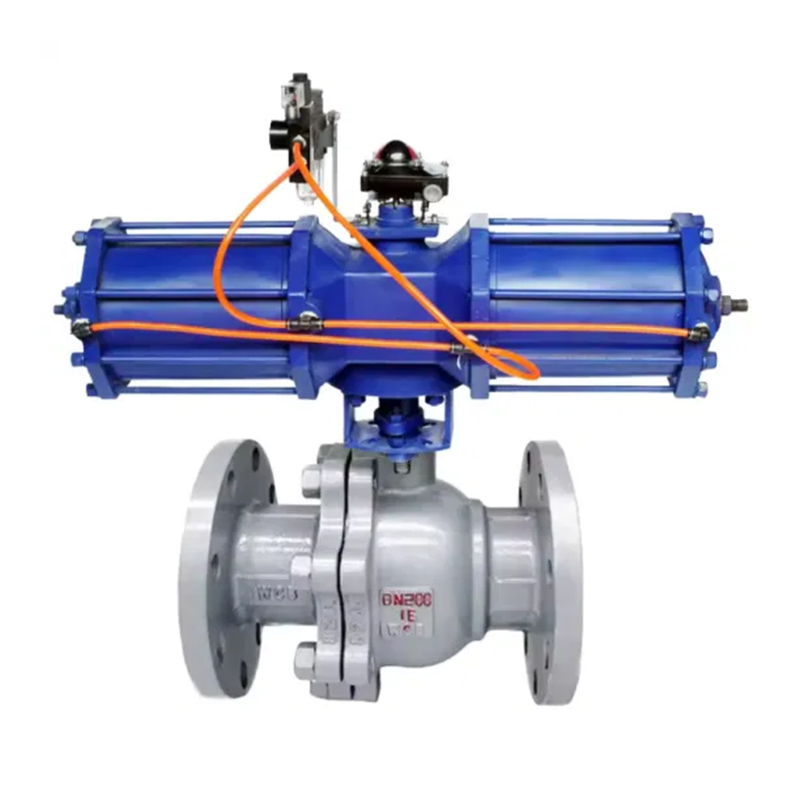0086 15335008985
Cat:Multi Turn Electric Actuator
The AUKEMA rotary intelligent electric actuator has two control types: AK intelligent switch type and AKM intelligent ad...
See Details
Design principle: bearing-like structure and efficient transmission mechanism
The core design of the scotch yoke pneumatic actuator lies in its unique bearing-like structure and efficient transmission mechanism. This design is inspired by the bearing principle in precision machinery. By simulating the rolling contact of the bearing, it achieves extremely low friction and efficient operation of the internal transmission components of the actuator.
Bearing-like structure: The inside of the shift fork pneumatic actuator uses alloy steel balls as the transmission medium, which forms rolling friction with the alloy steel shift fork. This design significantly reduces friction loss and heat accumulation caused by traditional sliding friction, thereby reducing energy consumption and improving the overall efficiency of the system. More importantly, the friction coefficient of rolling friction is much lower than sliding friction, allowing the actuator to respond and start faster after receiving the control signal.
Efficient transmission mechanism: The transmission mechanism of the fork-type pneumatic actuator relies on the close cooperation between the alloy steel balls and the fork. The balls roll in the guide groove of the shift fork, converting the linear motion of the piston into the rotational motion of the shift fork, thereby driving the opening and closing of the valve. During this process, the rolling path of the balls is precisely calculated and optimized to ensure the smoothness and accuracy of the transmission process. The selection of alloy steel materials ensures the high strength and wear resistance of the transmission components, further improving the reliability and service life of the actuator.
The technical characteristics of the scotch yoke pneumatic actuator are mainly reflected in its rapid response and precise control.
Quick response: Thanks to the bearing-like structure and efficient transmission mechanism, the fork-type pneumatic actuator can start and respond quickly after receiving the control signal. Its working response speed has been significantly improved compared to traditional actuators, and it can complete the conversion from static to motion in a very short time, realizing rapid opening and closing of the valve. This means higher production efficiency and more stable flow control for industrial applications that require frequent flow adjustments.
Precise control: The precise control of the fork-type pneumatic actuator is mainly reflected in the stability and accuracy of its transmission process. The rolling friction between the balls and the fork ensures minimal errors and extremely low wear during the transmission process. The actuator is equipped with a sophisticated feedback mechanism and adjustment device, which can monitor and adjust the opening and closing status of the valve in real time to ensure the accuracy and stability of flow control. This feature gives the fork-type pneumatic actuator significant advantages in industrial applications that require high-precision flow control, such as chemical industry, petroleum, electric power and other fields.
The scotch yoke pneumatic actuator has shown many advantages in practical applications, including strong adaptability, energy saving and high efficiency, and easy maintenance.
Strong adaptability: The fork-type pneumatic actuator can adapt to a variety of working conditions and valve types, including ball valves, butterfly valves, plug valves, etc. Its design is flexible and can be customized according to different application requirements, such as single-acting or double-acting modes, configurations of different torque outputs, etc. This enables toggle-type pneumatic actuators to find suitable application scenarios in a wide range of industrial fields, such as oil and gas, chemical industry, electric power, water treatment, etc.
Energy saving and high efficiency: The fork-type pneumatic actuator achieves the goal of energy saving and high efficiency by reducing friction loss and improving transmission efficiency. Compared with traditional sliding friction, its rolling friction transmission method can significantly reduce energy consumption and reduce the burden on the compressor, thereby saving production costs. The actuator is equipped with an intelligent control system that can automatically adjust the working mode and output power according to actual needs, further improving energy efficiency.
Easy to maintain: The structural design of the fork-type pneumatic actuator is simple and clear, and the component replacement and maintenance operations are simple and fast. Its main wearing parts are alloy steel balls and shift forks. These parts are not only wear-resistant and durable, but also easy to replace. The actuator is also equipped with a fault diagnosis and alarm system, which can monitor and report abnormal conditions in real time to facilitate timely maintenance and processing.